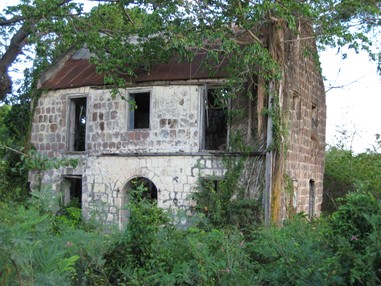On this site:
- Homepage:
Introduction
Aims of our research
The importance of Mountravers - The Mountravers Plantation Community, 1734 to 1834
The enslaved people
The employed men - Archival research
- Fieldwork:
Developments - Other work on Nevis:
Alexander Hamilton and 'Hamilton House'
Bath Hotel
British Library Endangered Archives
Bush Hill Estate
Clarke's Estate
Clifton Estate
Court House
Dasent's Estate
Early Steam Engines
Eden Browne Estate
Montpelier Estate
Scarborough's Estate
Stoney Grove Estate
Tower Hill Estate
Uprising, 1725: Frank's StoryWreck of HMS Solebay - Developments in Bristol
900 names
Servants in the family - Publications, reports and broadcast media
- Acknowledgments
- Contact details, and links to other sites
Mountravers Plantation (Pinney's Estate) - Nevis, West Indies
Christine Eickelmann and David Small
Archival research
One of the aims was to identify and record every enslaved person known to have lived on Mountravers, and to try and recreate their biographies. The main primary source was the collection of Pinney Papers held in Bristol University Library Special Collections; in addition many other original documents were consulted in the UK and in Nevis. The result was The Mountravers Plantation Community, 1734 to 1834.To get as complete a picture as possible about each individual, their lives prior to their arrival on the plantation have been examined and, if sold or freed, what happened to them after they left. In addition, the managers and overseers, their families and the enslaved people they held have been researched. As far as can be established, this has resulted in the first collection of biographies and biographical notes of an entire population on a West Indian sugar plantation from its early beginnings until the apprenticeship system replaced slavery.
The population of enslaved people
Research has established, among other things, that- in total, just over 900 enslaved individuals are known to have lived on Mountravers from its early beginnings in the seventeenth century until the abolition of slavery; their names are memorialised on a panel in a permanent exhibition in the Georgian House Museum, Bristol.
- of these, 743 men, women and children lived between 1734 and 1834; their biographies and biographical notes can be found in
Part 2, Chapters 2 to 7 of The Mountravers Plantation Community, 1734 to 1834. - at any one time there were between 19 (1696) and 211 (1795) enslaved people on the plantation
- at least 200 children were born on Mountravers
- between January 1765 and July 1768 John Pretor Pinney bought over sixty Africans, most of whom were said to have come from present-day Nigeria and Ghana
- in later years Pinney preferred buying Creoles (island-born individuals) from 'good families'.
The managers and overseers
Caribbean sugar plantations were complex businesses which, depending on their size, required a number of people to manage the land, the buildings, the animals and machinery, the plantation infrastructure and, of course, the enslaved workers and the commodities they produced: sugar, rum, and molasses. Resident planters ran their enterprise with the help of one or two men but when planters left the island, they entrusted their estates to managers and their subordinates, the overseers and seasonal boiling house watches. The stories of these employed men is told in Part 3 of The Mountravers Plantation Community, 1734 to 1834.
The ruined managers' house at Sharloes,
the lower part of the old Pinney's Estate
(D Small and C Eickelmann, 2008)